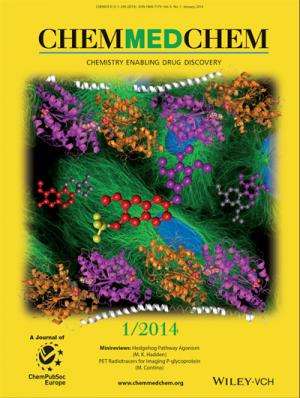The researchers designed an imaginative cover feature illustrating the drug molecule as a synthesis of discrete fragments, flanked by renderings of the target protein, tubulin. In the background is an image of cultured cells expressing recombinant tagged tubulin, labelled with a green fluorescent dye.
A publication on anti-cancer drug candidates designed by University of Bath researchers in the Department of Pharmacy & Pharmacology has been awarded Very Important Paper status by the medicinal chemistry journal ChemMedChem.
The paper entitled "Tetrahydroisoquinolinone-based Steroidomimetic and Chimeric Microtubule Disruptors" describes how the researchers designed the prototype drug using fragments derived from 2-methoxyoestradiol (an endogenous anticancer oestrogen metabolite) and colchicine (a compound extracted from a crocus) as templates. They then combined these together in new hybrid structures and modified them systematically to explore the effects on biological activity.
The work was carried out as part of the assets of Sterix Ltd – a University spin-out company with Imperial College – and, more recently, in collaboration with a specialist group in the USA.
Sterix Ltd was co-founded by Professor Barry Potter from our Department of Pharmacy & Pharmacology and was acquired by the pharmaceutical company Ipsen in 2004.
The paper appeared in this month's issue of the journal, which includes a special invited cover feature designed by the researchers.
Professor Potter said: "It is highly rewarding to see the creation of this new drug class from our synthetic laboratory and its high level pre-clinical development. It is also encouraging to see the ongoing academic peer recognition of our work.
"This work emphasises the continuing strength of medicinal chemistry at the University and demonstrates again that academic scientists can play a key role in discovering drug candidates – traditionally a preserve of the pharmaceutical industry."
Professor Potter also started work as an invited member of the ChemMedChem International Advisory Board at the beginning of January.
More information: "Tetrahydroisoquinolinone-Based Steroidomimetic and Chimeric Microtubule Disruptors." Dr. Mathew P. Leese, Dr. Fabrice L. Jourdan, Dr. Meriel R. Major, et al. ChemMedChem. Volume 9, Issue 1, pages 85–108, January 2014. DOI: 10.1002/cmdc.201300261
Journal information: ChemMedChem
Provided by University of Bath






















